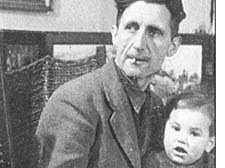|
|
 |
| |

George Orwell with his son Richard |
Why are there so few flags for our George?
Big Brother and Room 101 are everyday phrases, yet their curator is strangely uncelebrated, writes Gerald Isaaman
No writer of our time, at any rate no English writer, has so deeply influenced his contemporaries as Wells. He was so big a figure, he has played so great a part in forming our picture of the word, that in agreeing or disagreeing with his ideas we are apt to forget his purely literary achievement.”
Who wrote that? You will have to delve into this fascinating new addition to the intimate, compelling world of Eric Blair, alias George Orwell, to discover that these words come from Orwell’s obituary of HG, the draper’s boy whose ideas shook the world, but alas are remembered now more for blockbuster movie versions of The War of the Worlds, which ended, incidentally, on Primrose Hill, not in the stratosphere,
There has to be a poignant irony to it when you consider that today it is Orwell who deserves the supreme accolade. For no other author, apart from Shakespeare, has become so intertwined with today’s vernacular when Big Brother and Room 101 remain rampant on our TV screens, even if those taking part are grimly unaware of 1984 or even politics.
Much more than that, Orwell’s dire warnings of the ominous fate of modern man – his aim was to make political writing an art form has proved itself effortlessly and endlessly – under the spell of totalitarian dictatorship have proved so profoundly true.
There are now excellent biographies of Orwell, in particular that by DJ Taylor, and there is 20-volume Complete Works of George Orwell, the labour of love by Peter Davison who, now 80, has put together this additional tome of significant scraps and footnotes galore, correcting past mistakes and introducing new elements about a man perhaps more revered abroad as a remarkable genius than in his native land.
There are letters he wrote from his numerous local addresses – in Warwick Mansions, Pond Street, Parliament Hill, Lawford Road, Mortimer Crescent and Canonbury Square – some to subjects such as Observer editor Ivor Brown and his literary editor JC Trewin, who both lived in Hampstead.
There are his letters to Brenda Salkeld and other women, which reveal his polite yet desperate desire for sexual warmth as well as intellectual passion, even while married, yet rarely successfully indulged. Indeed, when you see photographs of his gaunt face and TB shattered frame, you wonder how he managed to survive without love while producing his stream of writing exposing the evils of poverty in either Paris or Wigan, the disease of brainwashing advertising, as in Keep the Aspidistra Flying, written in Hampstead, and the terrifying fantasies of power, as in Animal Farm and 1984.
There are the letters written by his wife, Eileen O’Shaughnessy, full of humour, insight and dedication to Orwell’s great gifts, yet, apparently, willing to live in debilitating penury with him in a tin-roofed shack in Wallingford, without electricity and running water.
She, too, was equally open to being seduced by the advances of others, in particular the mysterious Georges Kopp, Orwell’s close colleague and commander in the front line of the Spanish civil war, whom, the book reveals, was in fact a nasty Russian-born double spy, who mesmerised both Orwell and his wife. Yet Orwell, despite his acute antennae, could be bluffed like anyone else, as is perhaps shown in the list of crypto-Communists he provided for the British government, including the names of Charlie Chaplin, Katharine Hepburn, let alone the actor Michael Redgrave, writer JB Priestley and the Hampstead journalist Norman MacKenzie.
The nuances in Orwell’s own double life, the Eton boy who joined the working class, are themselves limitless, plus rare photographs too in this new book. They add memorably to the complex portrait of a complex man, who was swindled out of royalties and died, sadly regally unrecognised after a life of hard graft and relentless ambition, in University College Hospital, St Pancras, in January, 1950.
Yet, as the flags of St George fly for England in the World Cup, where are the flags for George? It’s oddly notable that Big Brother and Room 101 still surround us, along with a portrait plaque on the entrance to what was once Booklovers’ Corner, Pond Street, Hampstead, erected through the efforts of Ben Whitaker, Ian Norrie and myself, plus plaques at Parliament Hill and Lawford Road.
The TES suggests that the fourth plinth in Trafalgar Square ought to be George Orwell’s own, whether or not he admires the gaze of Nelson.
Orwell’s contribution to all our lives surely cannot be lost. We do need our heroes to enable us to keep smiling at trouble.
* |
| |
|
 |
|